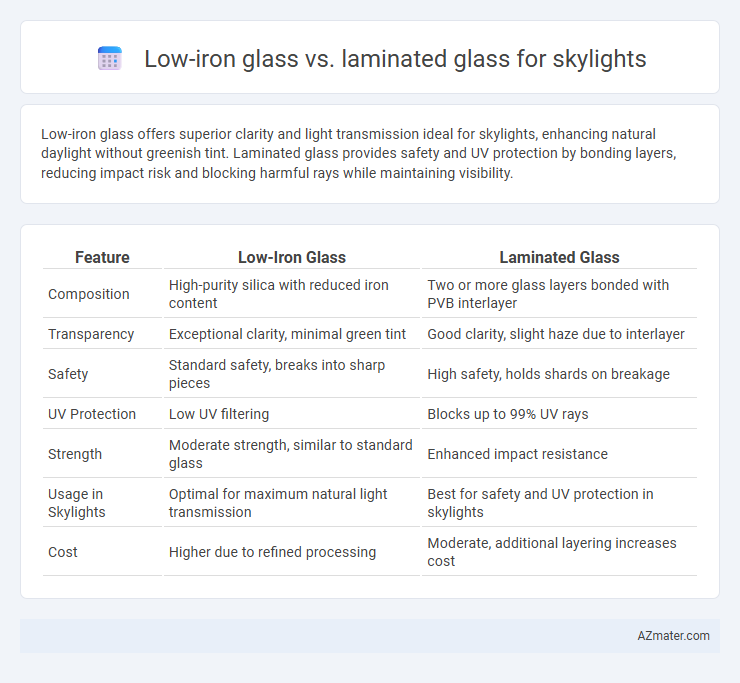Low-iron glass offers superior clarity and light transmission ideal for skylights, enhancing natural daylight without greenish tint. Laminated glass provides safety and UV protection by bonding layers, reducing impact risk and blocking harmful rays while maintaining visibility.
Table of Comparison
| Feature | Low-Iron Glass | Laminated Glass |
|---|---|---|
| Composition | High-purity silica with reduced iron content | Two or more glass layers bonded with PVB interlayer |
| Transparency | Exceptional clarity, minimal green tint | Good clarity, slight haze due to interlayer |
| Safety | Standard safety, breaks into sharp pieces | High safety, holds shards on breakage |
| UV Protection | Low UV filtering | Blocks up to 99% UV rays |
| Strength | Moderate strength, similar to standard glass | Enhanced impact resistance |
| Usage in Skylights | Optimal for maximum natural light transmission | Best for safety and UV protection in skylights |
| Cost | Higher due to refined processing | Moderate, additional layering increases cost |
Introduction to Skylight Glazing Options
Low-iron glass offers superior clarity and minimal green tint, making it ideal for skylights that require maximum natural light transmission. Laminated glass enhances safety and security by bonding multiple layers with an interlayer that holds shards in place upon breakage, also providing improved UV protection and sound insulation. Selecting between low-iron and laminated glass depends on prioritizing visual aesthetics or safety features in skylight glazing options.
What Is Low-Iron Glass?
Low-iron glass is a high-transparency material with reduced iron content to minimize the greenish tint common in standard glass, making it ideal for skylights that demand clarity and maximum natural light transmission. Compared to laminated glass, which consists of multiple layers bonded with a plastic interlayer for enhanced safety and sound insulation, low-iron glass offers superior optical quality but less impact resistance. Choosing low-iron glass for skylights enhances visual aesthetics and daylighting while laminated glass prioritizes durability and safety.
Understanding Laminated Glass
Laminated glass for skylights consists of two or more glass layers bonded with an interlayer, enhancing safety by preventing shards from falling if broken. This glass type offers superior impact resistance and UV protection compared to low-iron glass, which primarily focuses on clarity and light transmission. Understanding laminated glass's composition and benefits is crucial for ensuring durability, occupant safety, and energy efficiency in skylight installations.
Key Differences Between Low-Iron and Laminated Glass
Low-iron glass has higher clarity and light transmission, making it ideal for skylights where maximizing natural daylight is crucial. Laminated glass consists of two or more layers bonded with a plastic interlayer, providing enhanced safety, impact resistance, and noise reduction compared to low-iron glass. While low-iron glass excels in aesthetics and visibility, laminated glass offers superior structural strength and security features essential for skylight applications.
Optical Clarity and Light Transmission
Low-iron glass offers superior optical clarity and higher light transmission compared to laminated glass, making it ideal for skylights where maximum natural light and clear views are desired. Laminated glass, while slightly less transparent, provides enhanced safety and UV protection by sandwiching a polymer layer between glass sheets, which can mildly reduce light transmission. Choosing low-iron glass ensures brighter, more true-to-color environments, whereas laminated glass balances light quality with added structural benefits.
Safety and Security Factors
Low-iron glass offers enhanced clarity and natural light transmission in skylights but lacks the structural strength and impact resistance of laminated glass. Laminated glass consists of multiple layers with a polyvinyl butyral (PVB) interlayer that holds shards together upon breakage, significantly improving safety by preventing glass from shattering. For security purposes, laminated glass provides superior protection against forced entry and weather hazards, making it a safer, more secure option for skylights.
Durability and Weather Resistance
Low-iron glass offers enhanced clarity and superior light transmission but generally has lower impact resistance compared to laminated glass, making it less durable in harsh weather conditions. Laminated glass consists of multiple layers with a plastic interlayer, providing excellent durability, high impact resistance, and effective weather sealing, which prevents water infiltration and withstands strong winds. For skylights exposed to extreme weather, laminated glass is preferred for its combination of structural integrity and weather resistance.
Energy Efficiency and UV Protection
Low-iron glass enhances skylight energy efficiency by maximizing visible light transmission while minimizing heat gain, reducing the reliance on artificial lighting and cooling systems. Laminated glass provides superior UV protection by incorporating layers that block up to 99% of harmful ultraviolet rays, preventing interior fading and improving occupant comfort. Combining low-iron glass with laminated glass optimizes both natural brightness and UV shielding, leading to efficient energy use and long-term durability in skylight installations.
Cost Comparison for Skylight Projects
Low-iron glass for skylights typically costs 20-30% more than laminated glass due to its higher clarity and light transmission properties, enhancing indoor natural lighting. Laminated glass, while generally less expensive, provides superior safety and sound insulation, making it a cost-effective option for projects prioritizing impact resistance and noise reduction. Budget considerations for skylight projects should weigh the initial material costs against long-term benefits such as durability, maintenance, and performance needs.
Choosing the Right Glass for Your Skylight
Low-iron glass offers superior clarity and natural light transmission, making it ideal for skylights that prioritize aesthetic appeal and brightness. Laminated glass enhances safety and security with its inner interlayer that holds shards together upon impact, providing excellent durability and UV protection. When choosing the right glass for your skylight, consider whether visual clarity or safety features like impact resistance and UV blocking are your main priorities.

Infographic: Low-iron glass vs Laminated glass for Skylight
 azmater.com
azmater.com